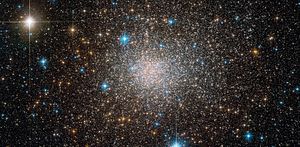| Terzan 5 | |
|---|---|
 Hubble image of Terzan 5 | |
| Observation data (J2000 epoch) | |
| Class | G2[1] |
| Constellation | Sagittarius |
| Right ascension | 17h 48m 05s[2] |
| Declination | −24° 46′ 48″[2] |
| Distance | 18.8 ± 1.6 kly[note 1] (5.9 ± 0.5 kpc[4]) |
| Apparent magnitude (V) | 12.8[1] |
| Apparent dimensions (V) | 1′02″ (half-mass diameter)[4] |
| Physical characteristics | |
| Mass | ~2×106[4] M☉ (4 × 1036 kg) |
| Radius | 2.7 ly[note 2] |
| VHB | 22.5[3] |
| Metallicity | = −0.21 dex |
| Estimated age | 12 Gyr[6] |
| Notable features | Possibly the core of a disrupted dwarf galaxy |
| Other designations | Ter 5, IRC–20385 |
Terzan 5 is a heavily obscured globular cluster belonging to the bulge (the central star concentration) of the Milky Way galaxy.[3] It was one of six globulars discovered by French[7] astronomer Agop Terzan in 1968[8] and was initially labeled Terzan 11. The cluster was cataloged by the Two-Micron Sky Survey as IRC–20385.[9] It is situated in the Sagittarius constellation in the direction of the Milky Way's center. Terzan 5 probably follows an unknown complicated orbit around the center of the galaxy, but currently it is moving towards the Sun with a speed of around 90 km/s.[6]
- ^ a b c Cite error: The named reference
Racine1975was invoked but never defined (see the help page). - ^ a b "Cl Terzan 5". SIMBAD. Centre de données astronomiques de Strasbourg. Retrieved 2009-12-04.
- ^ a b c Cite error: The named reference
Ortolani1996was invoked but never defined (see the help page). - ^ a b c d e f Cite error: The named reference
Lanzoni2010was invoked but never defined (see the help page). - ^ Cite error: The named reference
Ortolani2007was invoked but never defined (see the help page). - ^ a b Cite error: The named reference
Ferraro2009was invoked but never defined (see the help page). - ^ Gottlieb, Steve (August 1, 2000). "Deep-Sky Notebook: A Tour of Obscure Summer Globular Clusters". Sky and Telescope. 100 (2): 112. ISSN 0037-6604.
- ^ Terzan, Agop (1968). "Six nouveaux amas stellaires (Terzan 3-8) dans la region DU centre de la Voie lactee et les constellations DU Scorpion et DU Sagittaire". C. R. Acad. Sci. 267 (Ser. B): 1245–1248. Bibcode:1968CRASB.267.1245T.
- ^ Cite error: The named reference
King1972was invoked but never defined (see the help page).
Cite error: There are <ref group=note> tags on this page, but the references will not show without a {{reflist|group=note}} template (see the help page).
![{\displaystyle {\begin{smallmatrix}\left[{\ce {Fe}}/{\ce {H}}\right]\end{smallmatrix}}}](https://wikimedia.org/api/rest_v1/media/math/render/svg/4c0821bd80891e071c08e7c7ee8e022baedf522c)